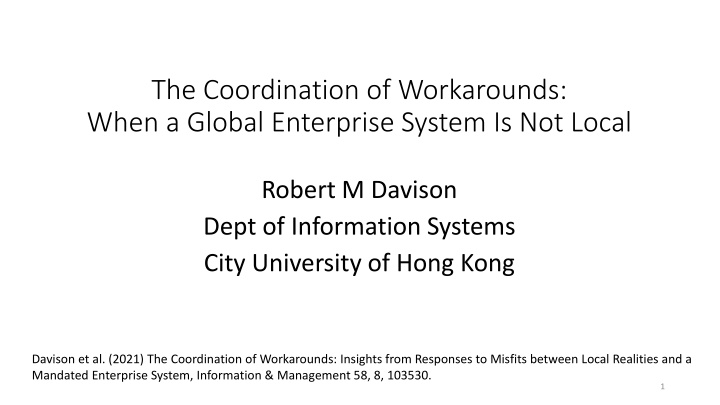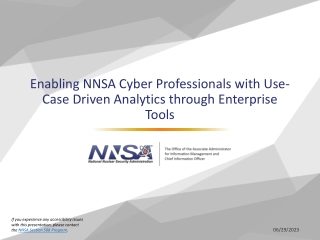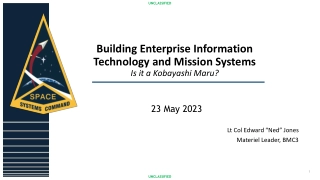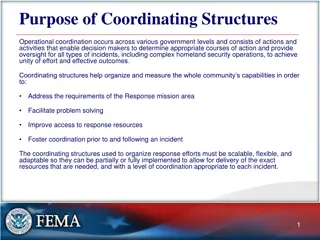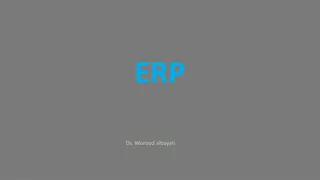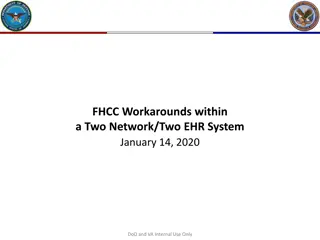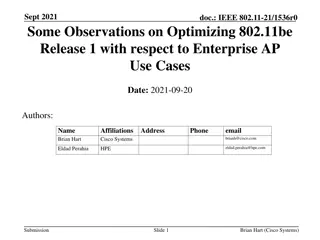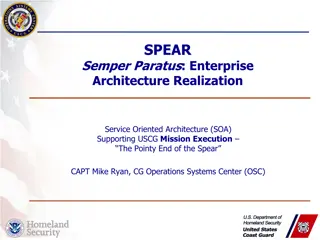Challenges in Coordinating Workarounds for Global Enterprise Systems
Global enterprise systems often do not align with local work processes, leading employees to find workarounds to get tasks done. However, the coordination of these workarounds poses challenges, as standardisation may clash with local realities. This study explores how employees in a global retail company navigate around an inadequate system, focusing on the use of Microsoft Navision as the ERP system.
Download Presentation

Please find below an Image/Link to download the presentation.
The content on the website is provided AS IS for your information and personal use only. It may not be sold, licensed, or shared on other websites without obtaining consent from the author.If you encounter any issues during the download, it is possible that the publisher has removed the file from their server.
You are allowed to download the files provided on this website for personal or commercial use, subject to the condition that they are used lawfully. All files are the property of their respective owners.
The content on the website is provided AS IS for your information and personal use only. It may not be sold, licensed, or shared on other websites without obtaining consent from the author.
E N D
Presentation Transcript
The Coordination of Workarounds: When a Global Enterprise System Is Not Local Robert M Davison Dept of Information Systems City University of Hong Kong Davison et al. (2021) The Coordination of Workarounds: Insights from Responses to Misfits between Local Realities and a Mandated Enterprise System, Information & Management 58, 8, 103530. 1
Agenda Introduction Background, Problematisation, Motivation Literature (Briefly) Research Context (Scatex) and Method Case Study The Employee Experience of Navision Emerging Barriers to Work Coordination of Workarounds as Persistent Solutions to Persistent Problems Discussion Conclusion 2
Introduction Standardisation may be the sine qua non for global managers eager to control the workforce and the organisation Software applications Hardware Work processes and procedures all embedded in policy statements But these standards don t always map well onto local work processes. If they are strictly enforced, completion of any work may be difficult Employees may then have to find new ways to get things done They work around the standardised processes and systems 3
Problems The designers of global systems seldom understand how work is done in multiple local situations They may not care not their responsibility Their job is to optimise not to localise They answer to the CEO/CIO/CSO but not to the system users There is research in this domain, but much of it concerns the actions taken by individual employees to solve individual problems These actions are often temporary and uncoordinated There is also an academic appreciation for resistance and workarounds, but the practitioner literature tends to be scathing Little corporate sense that workarounds could be beneficial. 4
Motivation So, what do employees do (collectively) when faced with an inadequate system? We explored this question in the HK operations of Scatex, a global retailer of household products Microsoft Navision is the ERP at the centre of the problem. Do employees respect the requirement to comply with IT policy, even though Navision does not fit their work requirements, or do they deviate in some way? 5
Literature Review 1 What is a workaround? There are many definitions. a goal-driven adaptation, improvisation, or other change to one or more aspects of an existing work system in order to overcome, bypass, or minimise the impact of obstacles, exceptions, anomalies, mishaps, established practices, management expectations, or structural constraints that are perceived as preventing that work system or its participants from achieving a desired level of efficiency, effectiveness, or other organisational or personal goals (Alter, 2014). But what about: who creates it? does it persist? is it embedded into organisational routines? is it coordinated or stand-alone? 6
Literature Review 2 Perspectives in the literature are sharply opposed Those who extol workarounds, and those who denounce them! Emancipation of the workforce or rejection of the managerial prerogative! Workarounds deviate from established practices (Azad & King, 2012) Workarounds may be the only way to accomplish work (Beerepoort et al., 2019) Some mangers do tolerate workarounds (R der et al., 2014) The literature tends to focus on enterprise systems and their workarounds Perhaps this because they are more standardising, controlling, important Hanseth et al. (2001): the ideal control technology Or perhaps employees have more problems with enterprise systems! But employee rejection of control is quite common 7
Literature Review 3 Employees may (individually or collectively) develop workarounds in order to bypass procedural controls (Ignatiadis & Nandhakumar, 2009) Or to cope with the challenges of mapping daily work routines to an ES (Subramaniam et al., 2013). Employees may either devise ways to work around enterprise social media (ESM) (Choudrie & Zamani, 2016) or leverage ESM in order to overcome inadequacies in redesigned business processes (Davison & Ou, 2017; 2018). 8
Literature Review 4 Employee compliance may seem ideal, but Workarounds may be non-compliant, but if workarounds help people get their work done and meet customer requirements, they must bring some value (Davison & Ou, 2017, 2018) Workarounds also provide the alert that something is wrong with the corporate system and needs fixing (Markus, 1983) Constructive deviance A better way of working (Mertens & Recker, 2020) Implying that compliance can be worse than non-compliance (Alter, 2015) Microsoft Excel is often the software of choice in ERP workarounds (Spierings et al., 2017) 9
Literature Reflection The phenomenon of workarounds is contested there are multiple and irreconcilable views The literature is also imprecise there is no agreement on a definition of workarounds Much of the literature focuses on cases of individual employees working alone There are few accounts of collective actions and none of coordinated actions The theorising tends to be very generic, which is problematic as the experience of workarounds varies enormously 10
Research Context Scatex is a Europe-HQed, globally operating enterprise with ~200k employees in ~400 stores in ~50 countries. Prior to 2010, there was no systems integration each location could do what it liked. From 2010-2016, a new global standardisation initiative using Navision was rolled out HK was almost the last place to go live. HK has five operating locations 4 retail shops and 1 warehouse. The Navision implementation was plain vanilla: no customisation at all, even though the local CIO explained repeatedly to the implementation team that it would not work due to non-standard working practices 11
Research Method Qualitative case study Interviews with 31 employees (approx. 10%) at all ranks in the warehouse GT approach to data coding and analysis The novel findings related to coordination and persistence of workarounds, which became the focus of our emerging contribution The data structure (Gioia et al. 2013) indicates a sample of the data 12
The Employee Experience of Navision Although some employees reported that Navision adequately supported their work processes, many disagreed. We identified several processes where there was a mismatch between Navision s software logic and the process logic of the work itself. This was not just a matter of employees preferring to work in a certain way that Navision did not support. Instead, Navision was simply unable to support some work altogether. Indeed, Navision was designed to fit the global environment, but not Hong Kong s local environment. 14
Instant and Delayed Picking Navision s software logic assumes that when a customer buys a product in the retail shop, the customer will take it away immediately. This is called instant picking . The item is picked from the shelf in the warehouse attached to the retail site and the customer takes it away. In Hong Kong, this is not possible. Land is very expensive, so retail stores are small and they don t have attached warehouses. Larger items are not pickable : they have to be delivered from the warehouse (located elsewhere) up to one week later. Hence, delayed picking . However, Navision cannot deal with delayed picking or the storage of stock post-sales but pre-delivery and the software was not customised to meet this requirement. 15
Workarounds 1 Common with other contexts, Microsoft Excel is the preferred software for most workarounds Employees in many different job functions described how they used Excel for a variety of purposes to emulate the pre-Navision software environment and thus complete work satisfactorily. Excel provides the functionality that Navision does not provide, a functionality essential to the completion of work NF: We insist to use workarounds because we just want to get the job done . JK: Basically 100% of my work involves workarounds . 16
Workarounds 2 MS: the delivery department has a very serious problem because Navision does not have the function of arranging delivery of goods. We use Excel to manage deliveries. Excel enables us to acquire the data for delivery that is sent to the delivery contractor. After gathering and sorting delivery information in Excel, we can determine the number of delivery vans required, the number of items to be delivered, the places to go, and the payment to the drivers. Excel is used to handle all these arrangements. Without Excel there is no way to undertake the delivery of goods . 17
Coordination 1 IY: we decide the workaround with the team. If the impact of our workaround is good, we keep using it; otherwise we will see how to improve it KL: the workarounds are known by our colleagues. We discuss how we do the workaround to avoid problems . TL: the workarounds are developed on a mutual basis by many colleagues . JA: we share the workaround with other colleagues so that everyone knows that if they face these problems they can use Excel to support their work . 18
Coordination 2 WhatsApp also sees extensive use for coordination: RY: I have ten WhatsApp groups for internal communication . JA: social media provides a platform for sharing information and increases efficiency . WhatsApp was particularly useful for employees who needed to be away from their desks because Navision only worked on the desktop. 19
Persistence 1 LT: despite reporting the software-process inconsistencies for 18 months, no solution had been proposed by management: workarounds are part of the regular work routine . RL: noted that workarounds follow an established method , TC: mentioned a training manual for workarounds MS revealed we have standard operating procedures for workarounds . NF: we do workarounds everyday because Navision cannot fit our work process needs 20
Coordination and Persistence The employees coordinate their workarounds to ensure their quality and, ironically, their standardisation. The high standards that they apply relates to their likely persistence The workarounds are both coordinated and improved, continuously. They are also persistent, being routinized at the team level and documented in a SOP manual for the benefit of future employees. The workarounds need to be dynamic: work processes change and indeed Navision itself may be updated. 21
Discussion Our focus on persistent workarounds is aligned with earlier work on productive deviance. As Beane (2017) notes, many scholars (cf. Suchman, 2007; Orlikowski, 1996) have demonstrated that organisations persist partly through deviation: people and practices adjusting to circumstances . Workarounds are tolerated because they are useful; they add value to multiple stakeholders. Persistence thus works at two levels. It characterises both the workarounds needed to get work done and the value of those workarounds to the survival of the organisation itself. 22
Discussion When workarounds are coordinated, it is more likely that they will create persistent benefits for different stakeholders, including the organisation itself These are not temporary solutions hidden in the shadows! They are permanent and overt ways of working that thrive in the light. But what of the corporate IT policy, the CSO, and all the rule breaking? That s future work, but our interviewees expressed no concern for ramifications: they ignored the policy and got on with their jobs. 23
Theoretical Considerations Could we develop a theory from this? I think we could but the scope is quite limited and particular (one warehouse in HK) (cf. Davison & Martinsons, 2016) How useful or applicable would that theory be? How representative is our context? Is any context?! Does it matter?! We can generalise to theory (Lee & Baskerville, 2003), and hope that scholars will test our theory in future. But they may find it hard to publish unless they improve or refute the theory given the expectation among editors and reviewers for theoretical novelty not replication. 24
Confusions in the literature Workarounds are often confused with resistance: a few scholars suggest that they are near synonyms Most prior work considers individual, not collective, behaviour. The notion of coordinated workarounds has not been mentioned before. We suggest that the notion of being coordinated is important: coordinated workarounds are likely to be higher quality, more useful and more persistent Temporary or Permanent? Most of the literature assumes workarounds to be short-lived, but they can be routinized (Pentland & Feldman, 2008). Harmful or Beneficial? The debate here is polarised. 25
Theoretical Reflections Broad statements about workarounds being individual or collective, temporary or persistent, coordinated or uncoordinated, harmful or beneficial, are often misleading. They vary a lot. Can a parsimonious theory accommodate so much variance? But a useful theory is one that is grounded in reality (Weick, 1989), so researchers with a theoretical bent must consider these characteristics carefully, be explicit about what is being worked around, and indicate whose point of view or perspective is taken. A doctor is too tired/lazy to use an EMR system compliantly and creates a workaround for the sake of convenience. But what about the view of the (dead) patient, (bereaved) family, hospital, insurance company, ? 26
Conclusion We expect that the workarounds created by Scatex employees will persist indefinitely, certainly so long as the underlying issues are not resolved We did not present the HQ s perspective: they ignored our communications. We urge more attention to workarounds: not all information systems work as planned or expected. We suggest that corporate systems and workaround (systems) will symbiotically evolve (they need each other), a hypothesis to be tested. 27
References 1 Alter, S. (2014). Theory of workarounds. Communications of the Association for Information Systems,34(55), 1041-1066. Alter, S. (2015). Beneficial noncompliance and detrimental compliance: Expected paths to unintended consequences. Proceedings of the 21st Americas Conference on Information Systems, Fajardo, Puerto Rico, August 13-15. Azad, B., & King, N. (2012). Institutionalized computer workaround practices in a Mediterranean country: An examination of two organizations, European Journal of Information Systems, 21(4) 358-372. Beane, M. I. (2017). Operating in the shadows: The productive deviance needed to make robotic surgery work, Doctoral dissertation, Massachusetts Institute of Technology. https://dspace.mit.edu/handle/1721.1/113956 Beerepoort, I., van de Weerd, I. & Reijers, H.A. (2019) The potential of workarounds for improving processes, Proceedings of the International Conference on Business Process Improvement, Sept 1-6, Vienna, 338-350. Choudrie, J., & Zamani, E. (2016) Understanding individual user resistance and workarounds of enterprise social networks: The case of Service Ltd, Journal of Information Technology, 31(2), 130-151. Davison, R.M., & Martinsons, M.G. (2016) Context is King! Considering particularism in research design and reporting. Journal of Information Technology, 31(3), 241-249. Davison, R.M., & Ou, C.X.J. (2017). Digital work in a digitally challenged organization. Information & Management, 54(1), 129 137. Davison, R.M., & Ou, C.X.J. (2018). Subverting organisational IS policy with feral systems: A case in China. Industrial Management and Data Systems, 118(3), 570-588. Davison, R.M., Wong, L.H.M., Ou, C.X.J. and Alter, S. (2021) The Coordination of Workarounds: Insights from Responses to Misfits between Local Realities and a Mandated Enterprise System, Information & Management 58, 8, 103530, 1-12. Gioia, D.A., Corley, K.G. & Hamilton, A.L. (2013) Seeking qualitative rigor in inductive research: Notes on the Gioia Methodology, Organizational Research Methods16(1), 15-31. 28
References 2 Hanseth, O., Ciborra, C.U. & Braa, K. (2001) The control devolution: ERP and the side-effects of globalization, The Database for Advances in Information Systems, 32(4), 34-46. Ignatiadis, I., & Nandhakumar, J. (2009). The effect of ERP system workarounds on organizational control. Scandinavian Journal of Information Systems,21(2), 59 90. Lee, A.S., & Baskerville, R.L. (2003). Generalizing generalizability in information systems research. Information Systems Research, 14(3), 221-243. Markus, M. L. (1983). Power, politics, and MIS implementation. Communications of the ACM,26(6), 430 444. Mertens, W. & Recker, J. (2020) Can constructive deviance be empowered? A multi-level field study in Australian supermarkets, Journal of Retailing and Consumer Services, 54, 1-12. Orlikowski, W.J. (1996) Improvising organizational transformation over time: A situated change perspective. Information Systems Research, 7: 63-92. Pentland, B.T., & Feldman, M.S. (2008). Designing routines: On the folly of designing artifacts, while hoping for patterns of action. Information and Organization,18(4), 235 250. R der, N., Wiesche, M., Schermann, M., & Krcmar, H. (2014). Why managers tolerate workarounds: The role of information systems. Proceedings of the 20th Americas Conference on Information Systems, Savanna, GA, August 7-10. Spierings, A., Kerr, D., & Houghton, L. (2017). Issues that support the creation of ICT workarounds: Towards a theoretical understanding of feral information systems. Information Systems Journal, 27(6), 775-794. Subramaniam, N., Nandhakumar, J., & Baptista, J. (2013). Exploring social network interactions in enterprise systems: The role of virtual co-presence. Information Systems Journal,23(6), 475 499. Suchman, L.A. (2007) Human-Machine Reconfigurations: Plans and Situated Actions. Cambridge University Press. Weick, K.E. (1989). Theory construction as disciplined imagination, Academy of Management Review, 14, 516-531. 29
